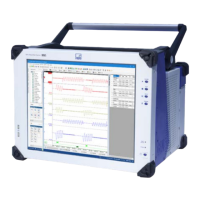GEN7iB
21
SAFETY MESSAGES
SAFETY MESSAGES
2
2.4 Protection and isolation
2.4.1 Measurement categories
● The international standards for test equipment safety are IEC 61010-1 and the IEC
61010-2-030.
● IEC61010-1denesthreeovervoltagecategories(CATII,CATIII,andCATIV)for
the power supply of an instrument.
● IEC61010-2-030denesthreemeasurementcategories(CATII,CATIII,andCAT
IV) for an instrument’s input measurements which can be directly connected to
mains supply.
● Allmeasurementinputswhicharenotspeciedtobeconnectedtothemains
power have no CAT rating and are referred to as O (like Others).
Categories in accordance with IEC 61010-2-030:2010
Electricalequipment,specicallymeasurementtools,canbeassignedintofour
categories in accordance with IEC 61010-2-030:2017. These measurement categories
are indicated by the terms O (previously CAT I), CAT II, CAT III and CAT IV. Originally,
these categories were used to indicate the overvoltage or surge voltage that was likely
to occur and could be sustained by the equipment. Currently, the category indicates
the amount of energy that can be released if a short circuit occurs. A higher category
number indicates a higher energy level that can occur and can be sustained by the
equipment.
O (Other) (previously referred to as CAT I: This category is for measurements not
directly connected to a mains supply. Measurements for this category are signal levels,
regulated low voltage circuits or protected secondary circuits. For this category, there
arenodenedstandardovervoltageorsurgeimpulselevels.
CAT II: This category is for measurements directly connected to a low voltage mains
supply. Measurements for this category are mains sockets in household applications
or portable tools. This category expects a minimum of three levels of overcurrent pro-
tection between the transformer and connection point of the measurement.
(See Fig. 2.1).
CAT III: This category is for measurements directly connected to the distribution part
of a low voltage mains installation. Measurements for this category are circuit break-
ers, wiring, junction boxes, etc. This category expects a minimum of two levels of over-
current protection between the transformer and connection point of the measurement.
(See Fig. 2.1).

